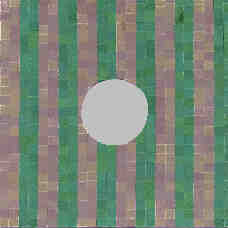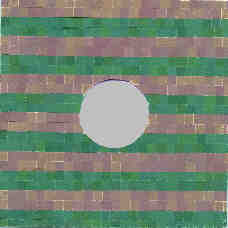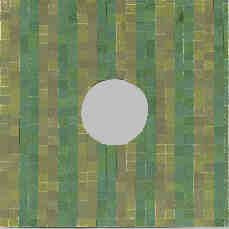
 Table of contents
Table of contents
Two surfaces that are matched in color, for a given observer under given illumination, are metameric if their spectral reflectances differ from each other within the visible spectral range. The metameric color match can be broken by the change of either the illumination (illumination metamerism) or the observer (observer metamerism). The question is if the birds color matching functions differ significantly from human ones to get high color mismatch for the ordinary painted surfaces.
In their ordinary life humans are hardly concerned for metamerism and intuitively take the specimens identical in color for identical in general. So, the main problem of the experiments, after the metameric specimens were painted, was to overcome this "intuition" in experimenters themselves. It looks as if we had more problems with metamerism than our birds.
To recognize close colors by memory is evidently more difficult for humans than to detect the difference in color between the surfaces presented side by side. When looking at our metameric paints one can hardly suppose that it is ever possible to remember the difference between the specimens to recognize them by color. Therefore, it was decided to supplement the task of color recognition with the easier task of form discrimination and to make something like pseudoisochromatic plates for the birds, with metameric colors presented side by side. For example, to discriminate orientations of the grid pattern made from alternating stripes of metameric colors. Moreover, in the form discrimination experiments it is possible to further facilitate the training procedure by using more distinct grids, and to use the metameric grids only in the test.
Contrary to the expectation, it turned out that it was more difficult to train the birds to discriminate grid orientation than to recognize colors metameric for human subjects, while the last task took as much time as simple color discrimination.
Subjects
The experiments were conducted in the mixed woods of the Moscow
and Vladimir districts on breeding pairs of hollow-dwelling small
passerine birds: pied flycatcher Muscicapa hypoleuca (three
nests), great tit Parus major (two nests) and redstart
Phoenicurus phoenicurus (one nest). We used the ability
of hollow-dwelling birds to find their nest with nestlings by
the features of the surroundings that could be changed in the experiment.
Procedure and Apparatus
In spring, nesting-boxes were hung up on trees where the birds
nested. When the nestlings hatched, the nesting-box with the nest
was gradually lowered to a height convenient for experiments.
Meanwhile, the birds were accustomed to the presence of the experimenters.
After that the birds were trained to find the true entrance to
the nest by special marks as conditioning stimuli - see Procedure in Pictures
for details (87K).
Experiments were conducted during day-light hours (with breaks)
over a period of a few days.
 Metameric paints
Metameric paints
Two sets, each of 10 color papers were painted with mixtures of
different blue and yellow mineral paints. According to their compositions
these sets will be referred to as FePb and CoCd. Despite the clear
difference between these sets in spectral reflectances (see figure),
all papers had close green colors for human observer under daylight illuminations.
To eliminate the influence of ultra-violet light both types of
papers were made equally "non-reflective" in this end of the spectrum
(about 6% reflectance for wavelengths below 380 nm).
These sets are metameric for humans under daylight illumination
in the sense of
1) the light, sent to the eye from all papers, causes close
calculated quantum catches by each cone type of the human retina, sensitive
to long- (L), medium- (M) and short-wavelength (S);
2) in the CIE standard colorimetric system all papers have close
tristimulus values, their colors occupying a compact locus in
the color space;
3) when observing the papers under daylight illumination humans
failed to identify the set by color of the paper;
4) human observers could select several pairs of papers from the
sets that matched in color.
Stimuli
 The stimuli were 10-12 cm squares with a central hole for
the entrance. For the color recognition experiments stimuli were
cut from the different painted papers. For the form discrimination
experiments stimuli were grid patterns made from alternating 1cm
wide stripes of two different metameric colors.
As far as the experimenters failed to agree about exactly which
specimens of painted papers matched in color, each stripe was composed
of small patches (5x5 mm) of different papers from the corresponding set.
This made the stripes invisible to all observers.
The stimuli were 10-12 cm squares with a central hole for
the entrance. For the color recognition experiments stimuli were
cut from the different painted papers. For the form discrimination
experiments stimuli were grid patterns made from alternating 1cm
wide stripes of two different metameric colors.
As far as the experimenters failed to agree about exactly which
specimens of painted papers matched in color, each stripe was composed
of small patches (5x5 mm) of different papers from the corresponding set.
This made the stripes invisible to all observers.
Stimuli with clear grid pattern (for humans) were made from gray/green,
blue/green and black/white pairs of color.
Illumination
When attached to the entrances, the stimuli were in equal lighting conditions.
The experiments were made with such nests and in such periods of day when the front
panel of the experimental box was illuminated by diffuse daylight with spectra
close to the Standard Illuminant D65.
Training and Testing
A non-trained bird usually shows one or another position habit in choosing the
entrance. It practically do not looks at the stimuli and flies straight into
the closest entrance from the wood. Usually, one can recognize that the bird
has learned the task by changes in its very behavior. Now, it first settled
on the perch and examines the entrances with the attached stimuli, and only
from there makes the choice.
Once it become clear that a bird had learned to fly to the necessary stimulus
despite the changes in its position, the last training session(s) was carried
out to score the bird's final performance. The pair of stimuli for this session
was replaced with a new one (made from the same papers) to exclude cues
other than coloration.
Testing was conducted with new pairs of stimuli, sometimes different from
the initial ones in color. Several consecutive test sessions used to be made
with various stimuli to get more reliable results.
Statistics
Birds feed nestlings in a very irregular manner.
Also many environmental factors affected the duration of experimental sessions.
So, the number of trials in sessions varied. Accumulated scores were analysed
with the binomial test for each session of a certain length.
 Calculated color coordinates of our papers under the two illuminants
are plotted on the CIE uniform chromaticity diagram and are shown
in figure at the left. As it can be seen from an enlarged insert,
under daylight illumination (D65) both FePb papers (blue points)
and CoCd papers (red points) have chromaticities intermixed
within the limited area. After change of the illumination (arrow)
colors of the sets are parted and occupy separate areas,
papers CoCd being less saturated than FePb (lie closer to the
illuminant color, indicated by the cross A).
Calculated color coordinates of our papers under the two illuminants
are plotted on the CIE uniform chromaticity diagram and are shown
in figure at the left. As it can be seen from an enlarged insert,
under daylight illumination (D65) both FePb papers (blue points)
and CoCd papers (red points) have chromaticities intermixed
within the limited area. After change of the illumination (arrow)
colors of the sets are parted and occupy separate areas,
papers CoCd being less saturated than FePb (lie closer to the
illuminant color, indicated by the cross A).



Besides, scanners use their own light source. So, in this case we meet both
observer metamerism and illuminant metamerism.
In other words, the color rendering of both camera and scanner were wrong in
the case of our color papers. This feature of scanned images of the metameric
paints created troubles in preparing this poster, for we failed to escape
the process of scanning. The examples of raw scanned metameric grids
(without subsequent tonal correction in graphical editors) are given below.


Different lights that look similar for human observer are not a rare case. Metameric lights are necessary tool in colorimetry. We all have met with an illuminant metamerism when trying to match clothes by artificial light at shops. Now it appears that it is not so difficult to make high metameric colors from ordinary mineral paints.
Color mismatch for such metameric pairs permits to detect

Authors are indebted to cohorts of unnamed students from Orekhovo-Zuevo Pedagogical Institute participating in experiments as observers during their practical works in zoology and to Vitaliy Vodyanov for photos.
2. E.N.Derim-Oglu, I.Yu.Pavlova, V.V.Maximov. Colour vision in pied flycatcher (Muscicapa hypoleuca). Zoologicheski zhurnal, 66, 1354-1362, 1987 (in Russian).
3. E.N.Derim-Oglu, V.V.Maximov. Small pacerines can discriminate ultraviolet surface colours. Vision Research, 14, 1535-1539, 1994.
4. V.V.Maximov, E.N.Derim-Oglu. Birds can discriminate human metameric colours. Perception, 25, Suppl., 98, 1996.
Back to IITP Laboratory 8 Activity Page
Back to IITP Electronic Posters Page
Back to IITP Projects Page ( IITP russian Projects Page )
Last Update: 20 February, 2001